How Planes Fly
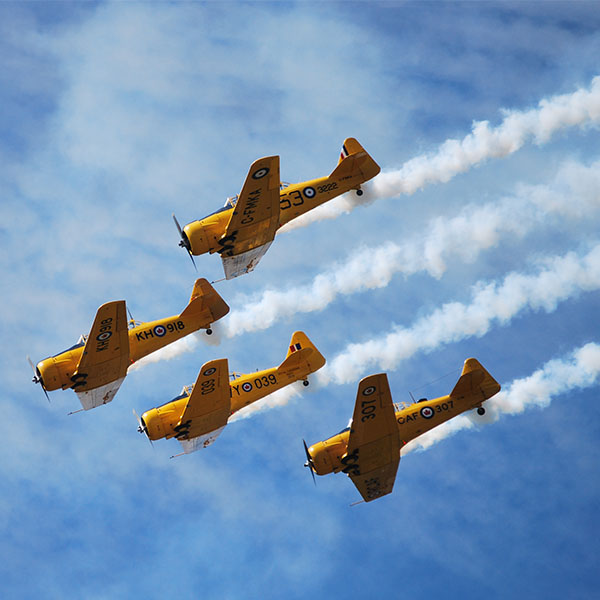
Four Harvard training aircraft (Scott Taylor. Used with permission).

Four Harvard training aircraft (Scott Taylor. Used with permission).
How does this align with my curriculum?
Learn about what gets planes up in the air, what keeps them up there, and what brings them down again.
Aircraft are everywhere these days. No matter where you live, chances are there's a commercial airline route somewhere above you. The image below shows the general routes taken by airlines all over the world. This picture doesn’t even include all of the local aircraft like air ambulances, private planes, and lighter-than-air vehicles!
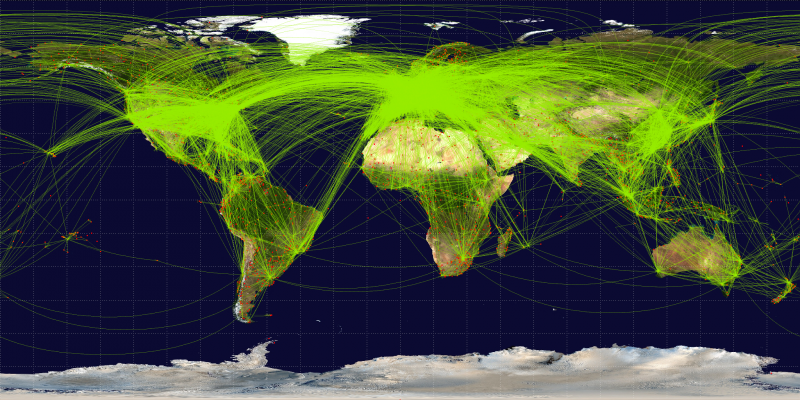
Image - Text Version
Shown is a map of the world. On it in bright green lines are airline routes. There are a lot of green lines originating in the Eastern United States, Europe and China. There are very few places on the map that routes do not touch.
That’s a lot of airplanes! Have you ever wondered how all those planes stay in the air? Or how do they get up in the air in the first place? Let’s explore how planes fly, and learn a lot about physics along the way.
A Little Bit of Background ...
Getting airplanes into the air and keeping them there requires knowledge about the properties of air, , and . We’ll tackle each of these in turn and then examine how we use these to get an aircraft in the air, keep it there, and then bring it back down again.
Air
is all around us. It makes up the layer above the Earth’s surface called the . Although it may seem like a single gas, it is actually a mixture of gases. This mixture is approximately 78 percent Nitrogen (N2), and 21 percent Oxygen (O2) with tiny amounts of water vapour (H2O), carbon dioxide (CO2), argon (Ar) and other gases.
Properties of Air
Air is made up of a large number of that are in constant, random motion. Since air has mass and takes up space, it can be measured in terms of its .
Like other gases, air is a . The word is often used as a synonym for ‘liquid’ but fluids include both liquids and gases. Fluids have the ability to flow as well as take the shape of their container. When fluids are compressed by a force, their molecules are pushed into a smaller space. This is called . Pressure is measured by dividing the force in (N) by the area in square metres (m2). The unit of pressure is the whose symbol is . 1 Pa equals 1 Newton per metre squared (1 N/m2). For large numbers, kilopascals (kPa) may be used.
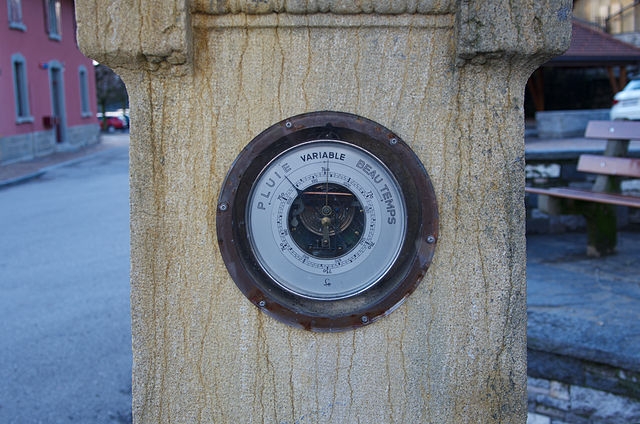
Image - Text Version
Shown is a colour photograph of a barometer outdoors on a stone platform. The barometer is circular. In the centre are gears and hands, similar to those of a clock. Like a clock, the barometer also has numbers around it indicating the barometric pressure. This one also has the words pluie (rain), variable and beau temps (good weather). This is because certain pressure readings are associated with different types of weather.
Since air pressure is caused by the weight of the air itself pushing down onto the surface of the Earth, air pressure is greatest close to the Earth. It decreases as increases. At the edge of space, the density of air is almost zero. This means that the barometric pressure of the air is also almost zero. and temperature also affect atmospheric pressure. When humidity goes up, pressure increases. This is because there are more molecules in the same space. In general, with increased temperature there is decreased pressure. This is because the molecules move faster and spread out more.
Since fluids flow, they can also be measured in terms of their . Viscosity describes a fluid’s resistance to flow. You can also describe this property as it’s ‘thickness.’ Fluids that are ‘thick’ and flow slowly, like molasses, are said to have a high viscosity. Fluids that are ‘thin’ and flow quickly have a low viscosity. The pressure and viscosity of air is important to flight because it can affect how an aircraft behaves. Below are some important values that engineers use when designing aircraft.
The values for a ‘standard day’ are average values used by engineers to design machines.
| Property | Dimensions | Value |
|---|---|---|
| Density | Mass/Volume | 1.229 kg/m3 |
| Pressure | Force/Area | 101.3 kPa (or kN/m2) |
| Temperature | Degrees | 15 °C |
| Viscosity | (Force x Time)/Area | 1.73 x 10-5 N·s/m2 |
The values for a ‘standard day’ are average values used by engineers to design machines.
Newton’s Laws
In addition to understanding the properties of air, it is also useful to understand some of the laws of physics related to forces and movement. The laws of physics that matter most here are Newton’s Laws of Motion. These laws were first described by Sir Isaac Newton in a work he published in 1687. Newton described three laws of motion which have been rephrased many times from the original Latin text. The most important parts of each are described below. To see how these relate directly to flight, please read this article on the four forces of flight!

Image - Text Version
Shown is an illustration of the principles of Newton's First Law. On the left is a man wearing a turban who is looking down at an empty shopping cart. This image represents an object that is at rest. Without being pushed, the cart will not roll. Beside this image is an image of the same man, only this time there are motion lines indicating that he has pushed the shopping cart and that it is moving away from him. This image represents an object in motion. If there were no external forces, the cart would roll along forever. Below the images is the heading "Law of Inertia" and in a text box "a body at rest will stay at rest and a body in motion will stay in motion unless acted upon by an unbalanced force".
Newton’s First Law of Motion
“An object at rest will remain at rest unless acted on by an unbalanced force. An object in motion will continue in motion with the same speed and in the same direction unless acted upon by an unbalanced force.”
So, what does this mean? Simply put, it means that objects tend to keep doing what they’re already doing. A cup sitting on the table isn’t going anywhere by itself. If you pick up the cup, though, you are applying an unbalanced force that makes the cup move upwards.
This law also applies to objects in motion. If you are travelling in a car and the car stops suddenly, then you will keep going at the same speed and in the same direction you were travelling before the car stopped. Newton’s First Law of Motion is the reason you should wear a seatbelt and make sure your airbags are working!
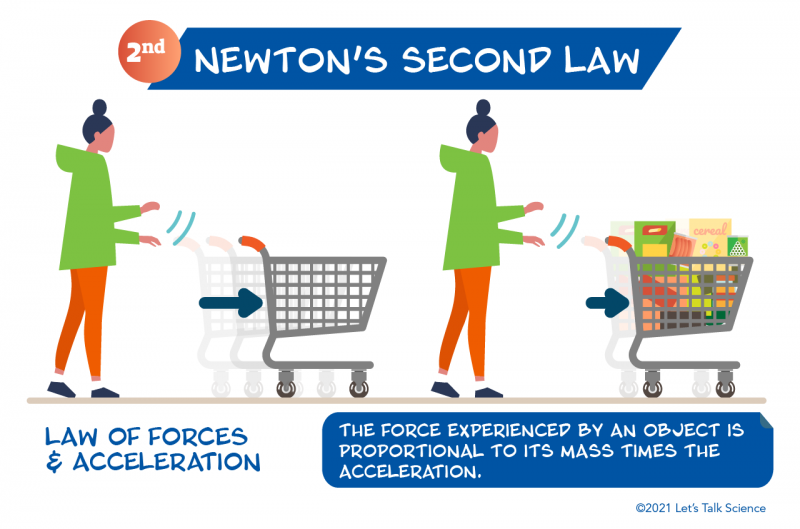
Image - Text Version
Shown is an illustration of the principles of Newton's Second Law.
On the left is a woman wearing a green hoodie and orange pants. Her hair is up in a bun. She is looking down at an empty shopping cart. There are movement lines by her hands indicating that she has pushed the shopping cart and it is moving quickly away from her. This is meant to demonstrate that an object with a small mass will have a large acceleration with a given force.
Beside this image is an image of the same woman, only this time the grocery cart is full of food. The motion lines indicate that the cart is moving slowly away from her. This is meant to demonstrate that an object with a large mass will have a small acceleration with a given force.
Below the images is the heading "Law of Forces and Acceleration" and in a text box "The force experienced by an object is proportional to its mass times the acceleration."
Newton’s Second Law of Motion
“The net force of an object is equal to the product of its mass and acceleration or F = ma.” F stands for force, m stands for mass and a stands for acceleration.
This law tells us that when a force acts on a mass, acceleration is produced. The greater the mass of the object, the greater the force necessary to accelerate it. We experience this law every day when we push and pull things. It takes a lot more force to push a cardboard box full of books across the floor than it takes to push an empty cardboard box across the floor. This law also tells us that for a given object, an increase in force means an increase in acceleration. You may have observed this when playing a game like soccer. When you lightly tap a soccer ball with your foot it moves a few centimetres. If you kick it really hard, though, it flies across the field.
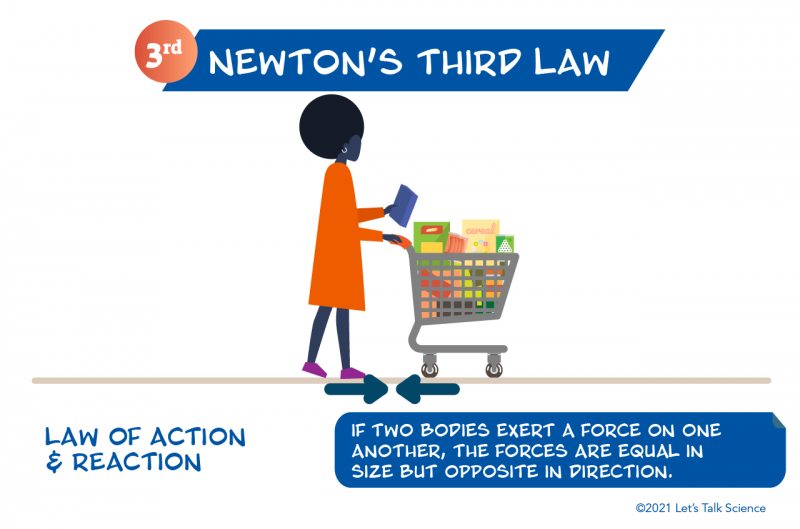
Image - Text Version
Shown is an illustration of the principles of Newton's Third Law. Shown is a black woman wearing an orange dress. She has a natural hairstyle. She is pushing a shopping cart with one hand and holding a piece of paper in the other hand. The grocery cart is full of food. Below her and the cart are two arrow that are facing each other. These indicate the directions of the forces applied by the woman on the cart and by the cart on the woman.
Below the images is the heading "Law of Action & Reaction" and in a text box "If two bodies exert a force on one another, the forces are equal in size but opposite in direction."
Newton’s Third Law of Motion
“For every action, there is an equal and opposite reaction.”
This is probably the best known of Newton’s three laws, but it can be a bit difficult to wrap your head around. According to Newton, whenever objects A and B interact with each other, they exert forces upon each other. For example, when you sit in a chair, your body exerts a downward force on the chair. At the same time, the chair exerts an upward force on your body. If the chair did not exert an upward force, where would you end up? On the floor! Whenever there is an interaction between two objects, there is a pair of forces called the and . The law says that the action is equal to the reaction. This means that the size of the force on the first object equals the size of the force on the second object. The law also says that the action is opposite to the reaction. This means that the direction of the force on the first object is opposite to the direction of the force on the second object. Forces always come in pairs: equal and opposite action-reaction force pairs.
These Laws of Motion are the physics underlying what are known as the four forces of flight. These four forces describe how an aircraft simultaneously moves up, down, forwards and backwards. This sounds impossible, but the way these forces combine and balance are what allows aircraft to fly. Below is a basic description of each of the four forces.
| Force | Brief Description |
|---|---|
| The force on an object due to gravity. | |
| The force that allows an object to overcome its weight. | |
| The force that pushes an aircraft forward. | |
| The force against the forward movement |
Putting it All Together
The motion of an aircraft through the air depends on the strength and direction of the four forces.
- If the forces are balanced, the aircraft cruises at constant velocity. This relates to Newton’s First Law.
- If the forces are unbalanced, the aircraft accelerates in the direction of the largest force. Again, this relates to Newton’s First Law.
The combination of the four forces enables aircraft to climb, cruise, and descend. Let’s see how this works in each of these situations.
Climbing
When an aircraft increases altitude, this is known as climbing. In this case, the four forces are unbalanced. In order to climb, the combined forces of thrust and lift are greater than the combined forces of weight and drag.
Thrust + Lift > Weight + Drag
When thrust is greater than drag, it is the unbalanced force that causes the aircraft to accelerate. In addition, as the velocity of the aircraft increases, the lift force increases. This becomes the unbalanced force that causes the aircraft to fly. Aircraft typically climb until they reach their cruising altitude and airspeed.
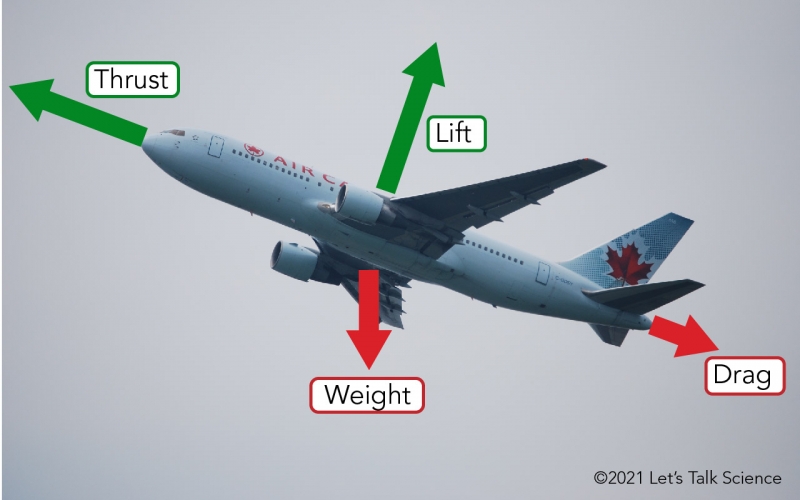
Image - Text Version
Shown is a colour photograph of a Boeing 767 that is used to demonstrate the location of forces when an aircraft is climbing. The aircraft is pointed towards the upper left corner of the image. Green arrows represent action forces and red arrows represent reaction forces.
Near the nose of the plane is a green arrow that is pointing in the direction of the plane's path it is beside a label indicating that this is the force from thrust.
Near the middle of the passenger compartment of the plane is a green arrow that is pointing upward, perpendicular to the plane. This is beside a label indicating that the force is from lift.
Also near the middle of the passenger compartment of the plane is a red arrow that is pointing straight down from the belly of the plane. This is beside a label indicating that the force is from the plane's weight.
Near the tail of the plane is a red arrow that is pointing away from the plane beside a label indicating that this is the force from drag.
Cruising
Once an aircraft is at its cruising altitude and airspeed, the four forces are balanced. In this case, the combined forces of thrust and lift are equal to the combined forces of weight and drag.
Thrust + Lift = Weight + Drag
When an aircraft is going at a constant horizontal velocity, then its is zero. From Newton’s Second Law (F = ma), if a = 0, then F = 0. In other words, the forces of thrust and drag are equal and opposite, so they cancel each other out. The same is true for altitude. When an aircraft is travelling in level flight it is going at a constant vertical velocity. In this case, its vertical acceleration is zero. As with its horizontal velocity, if a = 0 then F = 0. The forces of lift and weight are equal and opposite, so they also cancel each other out. An aircraft will continue to cruise with the same speed and in the same direction unless acted upon by an unbalanced force. We know this from Newton’s First Law). Once an aircraft begins to climb, descend, flies through less dense air, etc., the forces will become unbalanced.
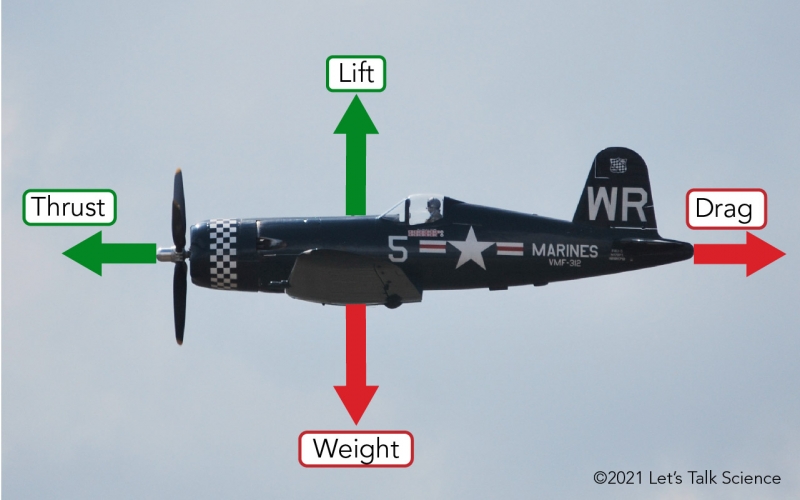
Image - Text Version
Shown is a colour photograph of a WWII navy fighter plane that is used to demonstrate the location of forces when an aircraft is cruising. The aircraft is horizontal and appears to be travelling to the left. Green arrows represent action forces and red arrows represent reaction forces.
Near the nose of the plane is a green arrow that is pointing in the direction of the plane's path. It is beside a label indicating that this is the force from thrust.
Just forward of where the pilot is sitting is a green arrow that is pointing upward, perpendicular to the plane. This is beside a label indicating that the force is from lift.
Also just forward of where the pilot is sitting is a red arrow that is pointing straight down from the belly of the plane. This is beside a label indicating that the force is from the plane's weight.
Near the tail of the plane is a red arrow that is pointing away from the plane beside a label indicating that this is the force from drag.
Descending
When an aircraft goes down, this is known as descending. As you might guess, in this case the four forces are once again unbalanced. In order to descend, the combined forces of thrust and drag are less than the combined forces of weight and drag.
Thrust + Lift < Weight + Drag
As an aircraft begins to land, thrust is decreased. Drag becomes greater and causes the aircraft to slow down. Lift decreases as velocity decreases. Once the aircraft touches the ground and decreases its velocity even more, lift dramatically decreases. When the aircraft is at rest again, weight is the only force of flight acting on the aircraft.
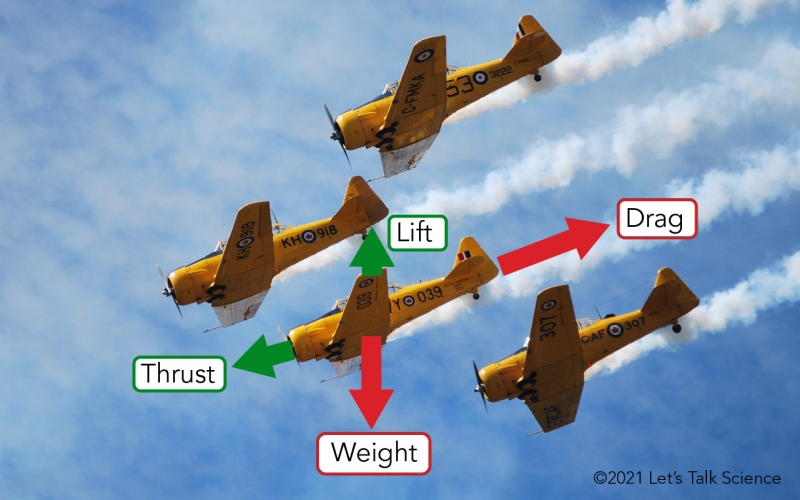
Image - Text Version
Shown is a colour photograph of a WWII training aircraft that is used to demonstrate the location of forces when an aircraft is descending. A group of four aircraft are flying in formation downward to the left corner of the image. Green arrows represent action forces and red arrows represent reaction forces.
Near the nose of one of the planes is a small green arrow that is pointing in the direction of the plane's path. It is beside a label indicating that this is the force from thrust.
Just behind where the pilot is sitting is a small green arrow that is pointing upward, perpendicular to the plane. This is beside a label indicating that the force is from lift.
Also just behind where the pilot is sitting is a large red arrow that is pointing straight down from the belly of the plane. This is beside a label indicating that the force is from the plane's weight.
Near the tail of the plane is a large red arrow that is pointing away from the plane beside a label indicating that this is the force from drag.
The study of physics is a big part of flight and there is a lot we can learn about physics by studying aircraft and how they are able to fly. For that, we can thank Sir Isaac Newton and his three Laws of Motion, which explain the relationship between forces and movement involved with flight. We can also thank aviation pioneers like the Wright Brothers. These two aviation pioneers helped to expand our knowledge in this area by inventing and building the world’s first successful airplane. This plane allowed them to make the first controlled, powered, and sustained heavier-than-air human flight on December 17th, 1903.

Image - Text Version
Shown is a black and white photograph of the first flight of a heavier-than-aircraft with a person onboard. The aircraft, the Wright Flyer, is a biplane with two sets of wings that are connected using thin vertical struts. The plane is flying less than a metre off the sandy ground in Kitty Hawk, North Carolina. The pilot, Orville Wright, is lying on his stomach centrally on the lower wing. Here he made the propeller turn by turning something that resembled the gears on a bicycle. A few metres away, his brother Wilbur looks on.
So the next time you take a trip up into the sky, think about all of the physics around you!
Learn More
How Airplanes Work
This section of the HowStuffWorks website has a lot of interesting information about how airplanes work.
How Aerobatics Works
This section of the HowStuffWorks website explains how stunt planes, better known as aerobatic planes, can fly in so many amazing ways!
How do airplanes fly upside down if it's the shape of the wings that make them fly? (2012)
This article, from Science Questions with Surprising Answers, answers this question.
References
Glenn Research Center (n.d.). The Beginners Guide to Aeronautics. NASA. Retrieved from https://www.grc.nasa.gov/WWW/K-12/airplane/
NASA (n.d.). Dynamics of Flight. Retrieved from https://www.grc.nasa.gov/WWW/k-12/UEET/StudentSite/dynamicsofflight.html#la
NASA (n.d.). Re-Living the Wright Way. Retrieved from https://wright.nasa.gov/airplane/shortw.html
NASA (n.d.). What Is Drag? Retrieved from https://www.grc.nasa.gov/WWW/k-12/airplane/drag1.html
NASA (n.d.). What Is Lift? Retrieved from https://www.grc.nasa.gov/WWW/k-12/airplane/lift1.html
NASA (n.d.). What Is Thrust? Retrieved from https://www.grc.nasa.gov/WWW/k-12/airplane/thrust1.html
NASA (n.d.). What Is Weight? Retrieved from https://www.grc.nasa.gov/WWW/k-12/airplane/weight1.html
Smithsonian National Air and Space Museum (n.d.). Exhibitions. Retrieved from https://airandspace.si.edu/exhibitions